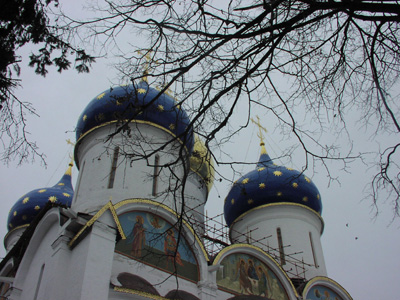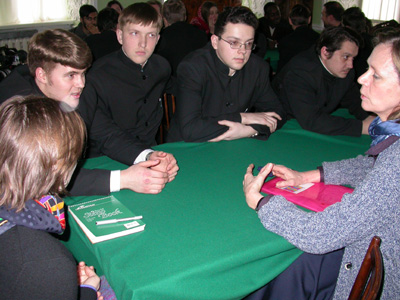
Spiritual Sojourn
St. Sergius provides lesson in humility for aspiring priests, reporters
By TIMOTHY LAVIN
Posted Thursday, March 20, 2003; 1:00 a.m.
 |
|
St. Sergius - Students admired the star-spangled domes of Cathedral of the Assumption through the trees at Holy Trinity. PHOTO: Dan Evans |
MOSCOW -
As the tour bus rumbled out of Moscow proper, morbid thoughts about
a looming war and the morning’s unyielding gun-gray sky lulled the
Columbia journalism students into contemplative lethargy.
Like war, religious ritual can provide a unique and novel prism for looking at the world. It can also be humbling. And during the Christian season of Lent, the themes of renewal and humility predominate.
With these
themes in mind, the students rode toward the Holy Trinity–St. Sergius
Monastery, in Sergiev Posad,a town 75 kilometers northeast of Moscow.
Andrei Zolotov, the group’s translator and guide, explained the cultural
and spiritual
significance of the site.
“We’ve said from the beginning of this trip that we can act
as reporters, as tourists or as pilgrims. Today, I would urge you to be
pilgrims,” Zolotov said. “The place where we’re going is
a holy site, a place of pilgrimage for six centuries. It means very much
to this country.”
He followed this with a somber blessing from an Orthodox prayer book which
he translated from Old Slavonic. “The way, the truth and the light
you are O Christ - please keep us safe and protect us from any evil. Travel
today with thy servants and protect them.”
As the bus rolled northeast, Moscow’s stark, cement bearing gave
way to small wooden houses with corrugated metal roofs. Plumes of factory
smoke yielded to sparse, snow-covered fields. The two-lane highway wound
past the town of Korolyov, home of the Russian space center, and into
Radonezh, a preparatory stop on the pilgrimage.
A small, semi-rural town, Radonezh is where busloads of tourists and the Orthodox faithful pay homage to St. Sergius, whom Zolotov described as one of the most revered of Russian saints.
St. Sergius spent his childhood in Radonezh before founding Holy Trinity and eventually becoming abbot of Russia in the 15th century.
Today, pilgrims pray at a tall stone pillar in the center of town dedicated to his memory and celebrate liturgy at a white brick church.
Inside that church, an Orthodox priest celebrated the liturgy of pre-sanctified gifts—a Lenten penance ritual similar to an Orthodox vespers, but including holy communion.
A female cantor chanted quietly while elderly women lit candles and crossed themselves. Younger worshippers kneeled humbly before a towering iconostasis - the partition between the laity and the altar.
The students
watched the ritual briefly then departed for the monastery, several miles
down the highway.
Sergiev Posad bustled with religious fervor. Holy Trinity Monastery, which
is surrounded by massive, white, fortress-like walls, dwarfed the small
town. Enclosed within the walls are numerous churches, the monks’
residence and a seminary.
Bearded clerics in black martial tunics patrolled the tree-lined paths. Legions of pilgrims and schoolchildren regularly visit various holy sites throughout the day beginning at 5 a.m.
Yelena Nikitana, a tour guide, led the group into the Refectory church, a gift to Holy Trinity from Peter the Great that is used both for worship and for entertaining eminent guests.
The ceiling in the church’s entryway depicted scenes from the Old Testament. Inside a long hallway is used for banquets. At the end of the hallway the main worship space, with gilded, intricate ornamentation shone brilliantly.
“The artwork you see here is sometimes called Baroque of Moscow,” said Nikitana. “It combines a European base with the bright style and solemnity of Asia.”
Gilded tombs contained the relics of St. Innocent and St. Philaret, famous clerics from Moscow.
“In the basement of the church, the monks provide free meals for the poor, up to 1,200 meals a day,” Nikitana continued, “Although during Lent, the meals provided are meager and plain.”
The group exited the Refectory and walked toward a green and white bell tower at the center of the monastic village. Built by St. Nikon in 1422, it contained eight small bells and two tremendous ones.
Catherine the Great had instituted a rule stating that no tower in Russia could exceed the height of the Kremlin, 81 meters. The bell tower itself was built precisely that high, but the monks later added a golden crown that added seven illicit meters.
Snow began to fall lightly and the group moved indoors. There they met other students of religion, the novices of the Moscow Theological Seminary and Academy.
 |
| St. Sergius -A group of English-speaking seminarians discuss religion with Adjunct Professor Celestine Bohlen, right, and student Sara Leitch, left. PHOTO: Meital Hershkowitz |
The two groups exchanged greetings through interpreters, then sat together for a discussion. Conversations ranged from comparative theology to rock music to the pending war, as the students provided mutual cultural education.
The seminarians talked about their austere lifestyle and their plans for entering the Orthodox clergy while the Columbia students discussed their own religious beliefs and impressions of Moscow.
Both groups were generally polite, but sometimes brutally honest.
“I don’t like Bush’s behavior, I don’t like his arrogance,” said Dmitry Goluber, a 32-year-old seminarian from Kazan. “It’s good to have cheap oil, to have a superpower, but I think that he only thinks about America’s prosperity, about dominating the world.”
But, he added, “Of course, many Americans are great people.”
Many of the seminarians’ dedication to the Orthodox faith left little room for ecumenical tolerance.
“I got the feeling they didn’t really want to talk to me about my own religion although they talked to everyone else about it,” said Muhammad Athar Lila, who had earlier explained to the group that he was a Muslim. “I thought that was very cowardly of them.”
But he added: “It’s a seminary, a place where they disseminate knowledge. I have a lot of respect for it. I don’t believe in the church but their dedication is inspiring.”
The groups spoke amicably for more than an hour in the freezing classroom, as portraits of severe Orthodox monks glared down from the walls.
Following
the roundtable, one seminarian led a tour through the seminary’s
museum, where the students learn art history, the mechanics and spiritual
significance of iconography and the difference between eastern and western
religious art from
the large collection of ancient artifacts, both Oriental and Russian.
Some journalism students struggled to pay attention and comprehend the museum’s significance.
“I don’t know that we can immediately access the depth of meaning that we saw today,” said Michael Serazio. “These symbols are new to us and while beautiful I don’t know how resonant they can be. I look at all those icons on the wall and they’re lovely but bland because I don’t know the faces.”
After the museum tour, students ate a sparse lunch of borsch and potatoes, which some washed down later with bottled holy water that poured from a cross in a nearby chapel.
Students moved on to the highlight of the pilgrimage: Trinity Cathedral. Inside, incense burned liberally and the now-familiar Orthodox adornments gleamed. A small choir chanted a simple prayer for St. Sergei, whose tomb sat on a platform at the front of the church, cradled in silver.
Many elderly and infirm faithful lined up, seeking his healing. As they approached one by one, the worshipers lit wooden candles, made the sign of the cross, and prostrated themselves, kissing the tomb. Then they rose, crossed themselves again, and exited the church, heads bowed.
Click
on to  photo
gallery
photo
gallery
< Dispatch Day 5: Previous Next: Dispatch Day 7>
Click
below to go to
Day 3 Photo Gallery:

QUICK
LINKS:
Feature
Stories | Dispatches
| Photo
Essays |
Itinerary
& Maps
|
About
This Class
A project of the Columbia University Graduate School of Journalism made possible by the Scripps Howard Foundation. Comments? E-mail us.
Copyright
© 2003 The Graduate School of Journalism at Columbia University.
All rights reserved. Reproduction in whole or in part without permission
is prohibited.





